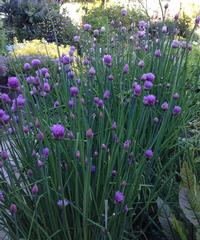Chives
Chives, Allium schoenoprasum, or "onion chives", are a herb belonging to the same family as garlic, scallions, and onions. They are grown for their edible leaves and flowers. The flowers are attractive to pollinators and are frequently visited by many types of bees. Grown in clumps, their slender leaves rise from an underground bulb. Chives can create attractive borders in the garden, and be pretty ornamentals in flower or rock gardens. Their blossoms are 1" spherical purple flowers. Leaves are frequently used to flavor salads, dips, soups, vinegars, egg/cheese dishes, sour cream, and butter. Their flavor is milder and more subtle than other members of the onion family and are best used raw. The edible chive flowers make attractive garnishes and are frequently used to prepare chive vinegar. The less common "garlic chives" (Allium tuberosum) have a mild garlic-like flavor and white flowers.
How to grow
- Type: Perennial, evergreen
- Light: Best in full sun, tolerates afternoon shade
- Soil: Well amended, good drainage
- Water: Likes moist to dry conditions; don't overwater
- Size: 12-20" high, 12-20" wide
When to plant/propagate
For chives, try to allow 6" clearance from other plants.
- From seed: Start seeds indoors 8-10 weeks before last frost date. Direct sow in full sun after last frost date
- Transplants: Space 8-12" apart with 8-12" between rows
- Cuttings: Propagate by division every two to four years
Harvesting
- Begin picking chives when the leaves are at least 6" tall
- Select some leaves on the exterior of the plant about 2" from the base. Cut with a scissors or a knife, leaving a few leaves for continuous growth. For most flavorful leaves, cut off the flowers. Flowers are edible, too. It's a good idea to pick the flowers before they go to seed, to keep the chives from becoming invasive
- Chives can be used immediately or stored under refrigeration for up to a week. The flavor will be more pungent in hotter weather. Plants can be cut back to about 3" high after flowering to force the plant to produce new, tender leaves
- Chives can be frozen or dried for later use, but the leaves lose a lot of flavor when dried
Indoors: Chives are good container plants and are easily grown in pots placed in a sunny location. Select containers with good drainage and fill with potting mix. Keep soil moist. Avoid overwatering. Small clumps can also be potted from the outdoor garden and moved indoors in the later fall to supply fresh leaves during the colder months
Common pests & diseases: Aphids
More information
- Grow Herbs!, UCCE Master Gardeners of Sacramento County
- Growing Herbs for the Kitchen, UCCE Master Gardeners of Napa County
Recommended Varieties for Santa Clara County*
See our list of Spring Garden Fair Herbs for varieties that we have found perform well here.
*Many other varieties may also do well here in Santa Clara County. This list is based on UC Master Gardener trials, taste tests, and feedback from local growers.







